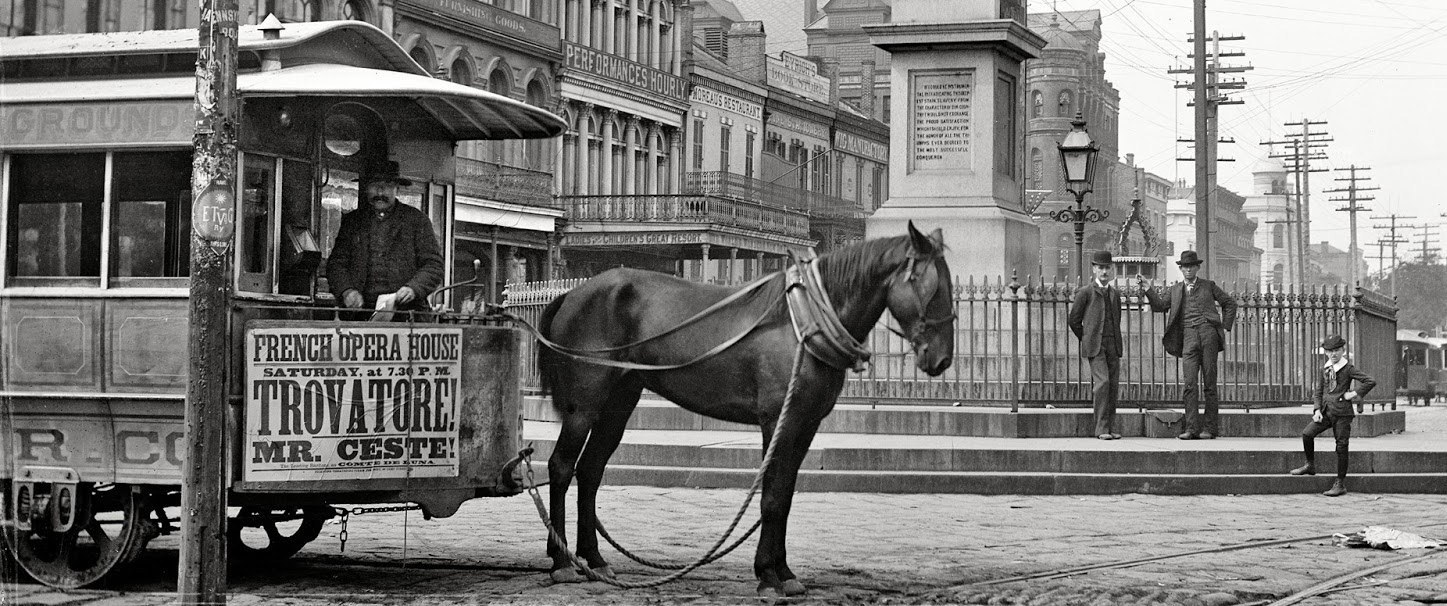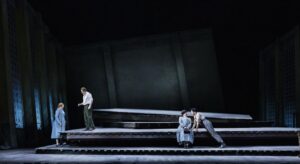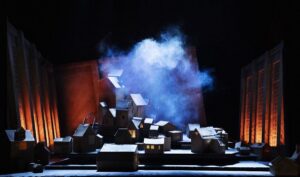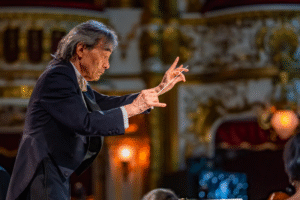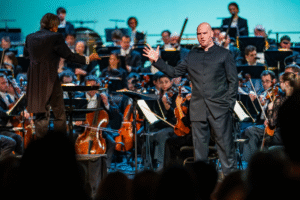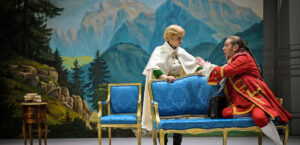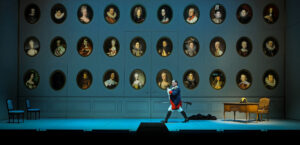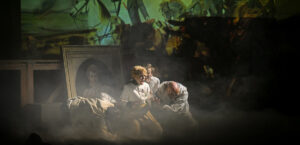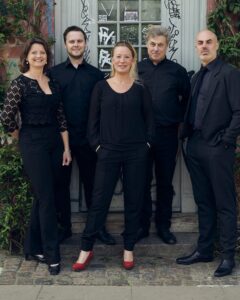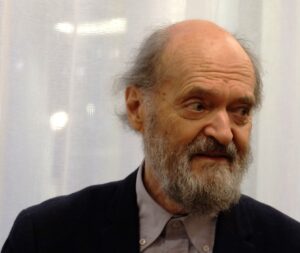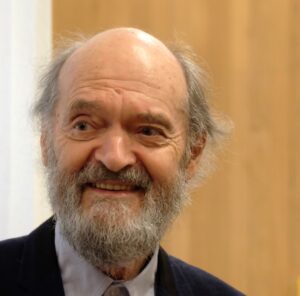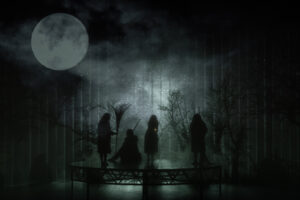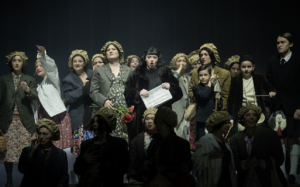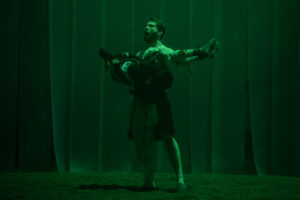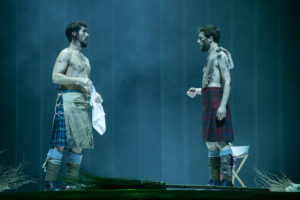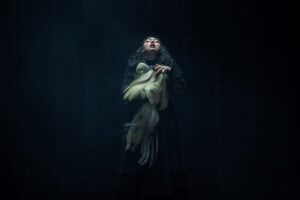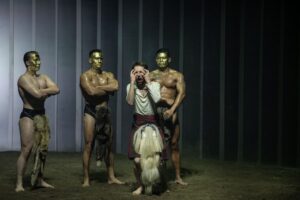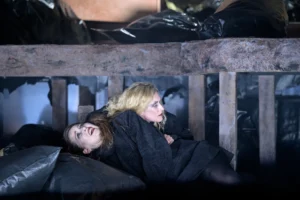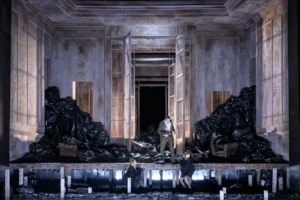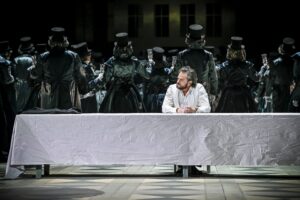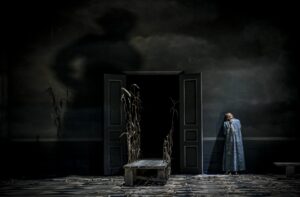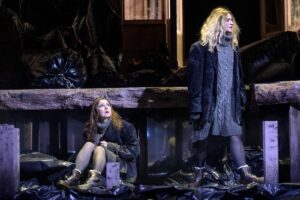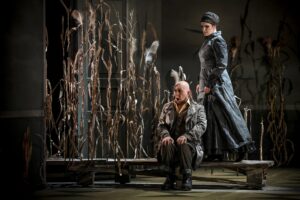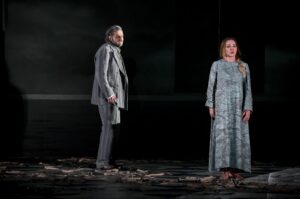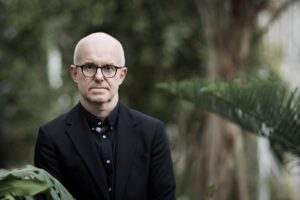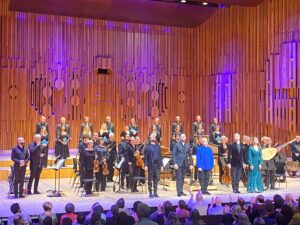Znad Sundu do brzegów Wełtawy
Nie samym Wagnerem człowiek żyje. Ale z brakiem jakiejkolwiek spójnej polityki oswajania polskiego odbiorcy z jego twórczością pogodzić się już trudniej. Chyba w żadnym europejskim kraju – nie wyłączając Włoch, które tradycję wagnerowską mają dość osobliwą – nie wystawia się i nie grywa jego dzieł tak rzadko jak u nas. Owszem, czasem przez scenę przemknie Latający Holender albo Tannhäuser. Tu i ówdzie pokażą Parsifala. W Warszawie, po blisko półwiecznej przerwie od czasu premiery skróconej wersji w Poznaniu, porwą się na Tristana: zresztą nie wiadomo po co, bo produkcja TW-ON z 2016 roku okazała się pod każdym względem katastrofą.
Śpiewaków norymberskich doczekaliśmy się po wojnie tylko raz, w poznańskim Teatrze Wielkim, w wykonaniu co najwyżej poprawnym. Pierścień Nibelunga inscenizowano po 1945 dwukrotnie: pod koniec lat osiemdziesiątych w Warszawie i dwadzieścia lat temu we Wrocławiu. Trojgu dyrygentów odpowiedzialnych na stronę muzyczną tych przedsięwzięć – Gabrielowi Chmurze w przypadku Śpiewaków oraz Robertowi Satanowskiemu i Ewie Michnik, którzy przygotowali odpowiednio Ring warszawski i wrocławski – należą się wyrazy uznania za upór w realizowaniu ambitnych marzeń, zwłaszcza w tak niesprzyjających warunkach. Były to jednak marzenia pod wieloma względami na wyrost.
Tymczasem zbliża się sto pięćdziesiąta rocznica premiery całości Pierścienia na festiwalu w Bayreuth, do której cały świat muzyczny przygotowuje się już od dawna. W Polsce rocznica przejdzie bez echa, w przeciwieństwie do obchodów szykowanych u naszych zachodnich sąsiadów (co poniekąd oczywiste), ale także w Czechach, gdzie wagnerzyści zetkną się z Tetralogią co najmniej dwa razy, między innymi w nowej inscenizacji Slávy Daubnerovej, planowanej na trzech scenach praskiego Teatru Narodowego. Nawiasem mówiąc, scenografię do tej produkcji – realizowanej etapami, począwszy od premiery Złota Renu w lutym 2026 – zaprojektuje Boris Kudlička, od przyszłego sezonu dyrektor TW-ON, kostiumy zaś bydgoszczanka Dorota Karolczak, która od lat pracuje niemal wyłącznie za granicą (o jej znakomitej oprawie plastycznej Rodriga na Festiwalu Händlowskim w Getyndze pisałam już sześć lat temu).
Śpiewacy norymberscy w Kopenhadze. Jessica Muirhead (Ewa), Magnus Vigilius (Walter), Hanne Fischer (Magdalena) i Jacob Scov Andersen (Dawid). Fot. Miklos Szabo
Wielbicielom twórczości Wagnera nie pozostaje zatem nic innego, jak tłuc się po całej Europie i wyszukiwać perły, jakich w Polsce nie uświadczy jeszcze co najmniej kolejne pokolenie melomanów. Na Śpiewaków norymberskich do Kopenhagi wybierałam się jednak pełna obaw – po rozczarowującej muzycznie i przygotowanej w bardzo nierównej obsadzie premierze inscenizacji Laurenta Pelly’ego w Teatro Real, zrealizowanej w koprodukcji z Den Kongelige Opera i Národním divadlem w Brnie. Madryckie przedstawienie znałam wyłącznie z transmisji. Wizualnie spodobało mi się nadzwyczaj, zupełnie mnie jednak nie przekonała interpretacja Pabla Herasa Casado: płaska, chwilami wręcz nudna i w całości pozbawiona wyrazu.
Tutaj za pulpitem dyrygenckim stanął jednak Axel Kober, stary wagnerowski wyga, który porwał świetnie przygotowaną orkiestrę Opery Kopenhaskiej od pierwszych taktów uwertury, prowadzonej lekką ręką, w żywych, ale niezagonionych tempach, z odpowiednią dozą niezbędnego, nieocierającego się wszakże o groteskę patosu. Osłupiałam z zachwytu, gdy ze sceny dobiegł śpiew chóru: mięsisty, zniuansowany dynamicznie, nienaganny intonacyjnie, z doskonale podanym i wyraźnie przemyślanym tekstem. A potem było jeszcze lepiej – mistrzostwo Kobera dało o sobie znać nie tylko w eksponowaniu charakterów poszczególnych postaci, lecz także w mądrym uwypuklaniu kontrastów tej partytury: między farsą a tragedią, monologami już to pełnymi czułości, już to ziejącymi nienawiścią, fakturą pięknie rozrzedzoną w duetach miłosnych i gęstą jak splot jedwabnika w oszałamiającej trawestacji Bachowskiej polifonii w finale aktu II.
Śpiewacy norymberscy są arcydziełem „stylu dojrzałego”, operą pełną sprzeczności i pułapek interpretacyjnych, których uniknęli zarówno dyrygent, jak zespół inscenizatorów. Laurent Pelly wyreżyserował całość w bardzo oszczędnej i pięknie operującej symbolem scenografii Caroline Ginet, z kostiumami projektu własnego i Jean-Jacquesa Delmotte’a. Akcja rozgrywa się w jednolitej przestrzeni, wyznaczonej przez kilka monumentalnych podestów i pionowych paneli, które na zmianę tworzą iluzję kościoła św. Katarzyny, nocnego nieba nad plątaniną ulic Norymbergi i rozległych błoni nad rzeką Pegnitz w Szwajcarii Frankońskiej. Resztę dopowiadają nieliczne rekwizyty: złocona rama, w której odchodzący w przeszłość meistersingerzy tłoczą się jak na staroświeckim portrecie; albo płótno z kolorowym górskim landszaftem, które w finale złowieszczo zblednie i opadnie, niczym zapowiedź nadciągającej katastrofy. Podobnych zwiastunów jest w tej inscenizacji więcej. Pelly przeniósł narrację na przełom XIX i XX wieku, w czas poprzedzający I wojnę światową, wplótł w nią jednak sygnały późniejszego zła. Tekturowe domki, z których scenografka zbudowała średniowieczną Norymbergę i które tłum w końcówce drugiego aktu obrócił w perzynę, w akcie III piętrzą się stosem śmieci, wciśniętym w głąb sielankowej scenerii. Kiedy Beckmesser zakrada się do warsztatu Sachsa, niespodziewanie truchleje na widok zawieszonego pod powałą pęku butów, który u części widzów wzbudza nieodparte skojarzenia z upiorną ekspozycją w muzeum Auschwitz-Birkenau.
Śpiewacy norymberscy. Finał II aktu. Fot. Miklos Szabo
Wszystko to jednak dociera na widownię jak przez mgłę, ledwie muśnięte, zasugerowane subtelną zmianą światła, rozładowane wybuchami śmiechu w świetnie rozegranych scenach farsowych. Od początku zwraca jednak uwagę misternie zbudowana postać Beckmessera, który ze sfrustrowanego łajdaka przeistacza się w budzącą współczucie ofiarę – szyderstwa tłumu, agresji Dawida, bezwzględności Sachsa. To zasługa nie tylko reżysera, ale też dyrygenta i niezwykle inteligentnego śpiewaka (Tom Erik Lie), który swą serenadą w II akcie wzbudza niepohamowaną wesołość, ale gdy na turnieju śpiewa „Morgen ich leuchte”, chichot grzęźnie nam w gardle, później zaś, kiedy zgodnie z intencją kompozytora rzuca się chyłkiem w tłum, czujemy w ustach gorzki smak wstydu.
Dopiero teraz zdałam sobie sprawę, że zaczynam ocenę obsady właśnie od Beckmessera, ale chyba po raz pierwszy zobaczyłam na scenie żywego, niedoskonałego człowieka, a nie groteskową figurę podstarzałego zalotnika. Pęknięta jest także postać Sachsa, w którego finałowej przemowie zaczynają pobrzmiewać tony mrożące krew w żyłach – tym bardziej dobitnie, że wspaniały, złocisty w barwie bas-baryton Johana Reutera zdaje się śpiewać całkiem o czymś innym. Duński artysta stworzył w tej partii jedną z najbardziej zapadających w pamięć kreacji, z jakimi kiedykolwiek miałam do czynienia: głosem niedużym, ale prowadzonym po mistrzowsku, z niewiarygodnym wyczuciem słowa i niesionych przez nie treści. W tym miejscu powinnam rozpocząć litanię pochwał pod adresem wszystkich, doskonale obsadzonych w swych rolach śpiewaków. Niech mi będzie wybaczone, że wspomnę tylko o wspaniałej Ewie w ujęciu obdarzonej świetlistym lirycznym sopranem Jessiki Muirhead; niezwykle przekonującym, także urodą żarliwego młodzieńczego tenoru Jacobie Scovie Andersenie (Dawid); wzruszającej ciepłem głosu mezzosopranistce Hanne Fischer w roli Magdaleny; oraz nieoczywistym, bardziej kruchym i zagubionym niż imponującym potęgą autorytetu Jensie-Eriku Aasbø w basowej partii Wita Pognera. Spośród protagonistów odrobinę słabiej wypadł Magnus Vigilius, dysponujący zdrowym i pięknym w barwie, lecz niezbyt elastycznym Jugendlicherheldentenorem – choć i tak uważam, że duński śpiewak plasuje się w pierwszej dziesiątce najlepszych odtwórców roli Waltera na świecie.
Świadoma, że Wagnera muszę nasłuchać się na zapas, następnego dnia ruszyłam do Pragi – na Zygfryda, czyli kolejną zapowiedź przyszłorocznej trasy koncertowej z całością Pierścienia Nibelunga na instrumentach z epoki, pod batutą Kenta Nagano. Pisałam już o tym na łamach „Tygodnika Powszechnego”, nie wdając się jednak w szczegóły istotne z punktu widzenia obecnej relacji. Po pierwsze, że prezentacja poszczególnych członów Tetralogii w tym ujęciu rozpoczyna się w stolicy Czech, nie bez powodu jedynym mieście środkowoeuropejskim na trasie Dresdner Festspielorchester i Concerto Köln, dokąd Pierścień trafił niespełna dekadę po prapremierze w 1876. Po drugie, że projekt „Ring historisch informiert” nie sprowadza się wyłącznie do rekonstrukcji historycznego składu orkiestry. To potężne, długofalowe przedsięwzięcie, realizowane z udziałem muzykologów, historyków teatru, językoznawców i antropologów – mające na celu nie tylko odtworzenie pierwotnego brzmienia Tetralogii, ale też jej kontekst kulturowy: ówczesną praktykę podawania tekstu, sposób kształtowania dramaturgii i zgodną z duchem epoki koncepcję czasu muzycznego.
Zygfryd w Pradze. Kent Nagano. Fot. Václav Hodina
Jak się łatwo domyślić, projekt od początku zyskał tyluż entuzjastów, ilu zagorzałych przeciwników – zwłaszcza wśród wielbicieli stentorowych, rzekomo wagnerowskich głosów. Przyznaję, że słuchając poprzednich członów „historycznego” Pierścienia z nagrań, też miałam wątpliwości, zwłaszcza co do obsady Walkirii, moim zdaniem zanadto „charakterystycznej”, niedostającej poziomem do oczekiwań samego kompozytora, który swych wymarzonych bohaterów poszukiwał wśród najsprawniejszych wykonawców partii z oper Rossiniego, Donizettiego i Meyerbeera. Do sztuki dyrygenckiej Kenta Nagano mam jednak stosunek nabożny, i to od początku mojej kariery w zawodzie krytyka muzycznego. To on przekonał mnie do symfoniki Brucknera – interpretacjami rozjaśniającymi pogmatwaną fakturę tych utworów i uwalniającymi je spod dyktatu ulubionego przez innych kapelmistrzów muzycznego „barbarzyństwa”. To on zdumiał mnie wszechstronnością swojego talentu, za której sprawą równie przenikliwie odczytuje partytury Beethovena i Brahmsa, jak Messiaena i kompozytorów współczesnych.
Nie zaskoczyło mnie więc, że głównym bohaterem praskiego koncertowego wykonania Zygfryda w Operze Państwowej okazała się orkiestra – mimo rozbudowanego składu bynajmniej nie homogeniczna, uwydatniająca osobliwości brzmieniowe poszczególnych grup, czasem nawet pojedynczych instrumentów. Z gęstej masy orkiestrowej zaczęły wyłaniać się nie tylko motywy przewodnie, ale też mniej oczywiste elementy Wagnerowskiej retoryki muzycznej: szerokie frazowanie, dyskretne glissanda, mocno zaakcentowane portamenta. W kwintecie nareszcie na pierwsze miejsce wysunęły się przemawiające niemal ludzkim głosem altówki, w dętych odezwał się szum listowia i pohukiwania leśnych stworów, w perkusji – świsty i pomruki nieubłaganych żywiołów. Całość zyskała całkiem inny koloryt – za sprawą niższego stroju, odmiennej konstrukcji i budulca instrumentów, a w rezultacie także szczegółów artykulacji.
Publiczność powoli oswaja się z wykonawstwem historycznym XIX-wiecznej muzyki instrumentalnej; próby rekonstrukcji ówczesnych praktyk wokalnych wciąż jednak trafiają na opór, także w kontekście formy operowej. Dotyczy to zwłaszcza tak zwanego śpiewu wagnerowskiego, który na dobrą sprawę jest konstruktem anachronicznym, wykształconym kilkadziesiąt lat po śmierci kompozytora, częściowo za sprawą mylnej interpretacji jego pierwotnych intencji. Tymczasem Wagnerowi zależało na specyficznej barwie i ekspresji, przywodzących na myśl brzmienie naturalnego głosu mówionego – w połączeniu z techniką, którą dziś kojarzy się prawie wyłącznie z włoską i francuską operą romantyczną. Przede wszystkim zaś kompozytor wymagał od swoich śpiewaków umiejętności „opowiadania” muzyką, budowania roli na zasadach obowiązujących ówczesnych aktorów dramatycznych.
Zygfryd. Na pierwszym planie Derek Welton (Wędrowiec). Fot. Václav Hodina
Od tego wyszli uczestnicy projektu Dresdner Musikfestspiele i o tym wspominał sam Nagano, podkreślając, jak trudno znaleźć śpiewaków wystarczająco utalentowanych, a zarazem skłonnych wyzbyć się żądzy popisu i poświęcić wiele miesięcy na interpretację tekstu, opanowanie i zintegrowanie dawnych technik aktorskich z praktyką wokalną. Trudno zatem się dziwić, że w przedsięwzięciu uczestniczą artyści mniej znani, często stawiający pierwsze kroki w wykonawstwie twórczości Wagnera. To pierwszy zakrojony na taką skalę eksperyment w historii. Muzycy, nie wyłączając dyrygenta, uczą się także na błędach. Mam wrażenie, że w Zygfrydzie zbliżyli się wreszcie do upragnionego celu: świadczy o tym choćby powierzenie roli tytułowej Thomasowi Blondelle, dysponującemu głosem niezbyt dużym, ale świetnie postawionym i atrakcyjnym w barwie – co w połączeniu z przemyślaną interpretacją postaci pozwoliło mu wcielić się w Zygfryda zgodnego zarówno z literą libretta, jak i partytury: przedwcześnie rozwiniętego, a przy tym naiwnego i chwilami okrutnego nastolatka, który rozpaczliwie zmaga się z kryzysem dojrzewania.
W trzecim akcie Blondelle znalazł doskonałą partnerkę w osobie Åsy Jäger, Brunhildy młodzieńczej, obdarzonej roziskrzonym sopranem o potężnym, na ogół jednak umiejętnie kontrolowanym wolumenie. Bracia Nibelungowie – Christian Elsner jako Mime i Daniel Schmutzhard w roli Alberyka – w pełni zaufali partyturze, nie próbując podkreślać moralnej brzydoty swych bohaterów środkami typowymi dla śpiewu charakterystycznego. W ten sposób, na przekór wciąż obowiązującej praktyce wykonawczej, stworzyli postaci niejednoznaczne, naznaczone wyraźnym rysem tragizmu. Doskonałym pomysłem – zgodnym skądinąd z konwencją epoki – było umieszczenie Fafnera w głębi sceny i wyposażenie go w metalową tubę, dzięki czemu głos smoka brzmiał tym bardziej przepastnie i złowieszczo (Hanno Müller-Brachmann wyszedł na proscenium tylko na ostatnie, przedśmiertne frazy olbrzyma, zaśpiewane już naturalnym głosem, jakby na znak utraty jego czarodziejskiej mocy). Szkoda, że nie wspomniano z nazwiska znakomitego chłopięcego sopranisty z Tölzer Knabenchor w roli Leśnego Ptaszka. Odrobinę rozczarowała mnie tylko Gerhild Romberger (Erda), dysponująca mezzosopranem pozbawionym niezbędnego w tej partii bogactwa brzmienia i kontraltowej głębi, co jednak udało się w pewnym stopniu zniwelować znakomitym aktorstwem.
Najwspanialszą kreację wieczoru stworzył jednak Derek Welton. Od czasu, kiedy ostatni raz słyszałam go w roli Wędrowca, jego głos nabrał szlachetności i autorytetu, przede wszystkim jednak doskonale przysłużyło mu się obniżenie stroju orkiestry do wersji pierwotnej. Australijski śpiewak swobodniej porusza się w dolnym zakresie swego jędrnego i soczystego bas-barytonu, co kiedyś wiązało się z rozrzedzeniem barwy na górnych dźwiękach tej dość wysokiej partii. Tym razem, pod czujną batutą Nagano, Welton sięgnął ideału – z tak muzykalną interpretacją postaci Wędrowca, przemyślaną, wywiedzioną wprost z tekstu i podpartą nieskazitelną techniką wokalną, nie miałam do czynienia od dawna.
Podobnych przeżyć, może jeszcze bardziej intensywnych, spodziewam się w przyszłym sezonie – nie tylko w Pradze i Kopenhadze, ale i wszędzie, gdzie twórczość Wagnera wciąż jest przedmiotem zachwytów, dociekań i niekończących się polemik. Na szczęście lubię podróżować.
